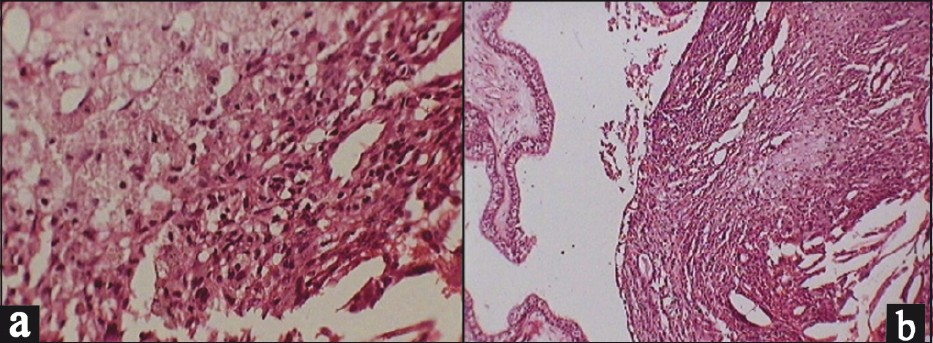Translate this page into:
Unusual presentation of xanthogranuloma of the choroid plexus
Address for correspondence: Dr. Jayaprakash Shetty, Professor & HOD Pathology, K S Hegde Medical Academy, Deralakatte, Mangalore, India. E-mail: drjpshetty9@yahoo.com
This is an open-access article distributed under the terms of the Creative Commons Attribution-Noncommercial-Share Alike 3.0 Unported, which permits unrestricted use, distribution, and reproduction in any medium, provided the original work is properly cited.
This article was originally published by Medknow Publications and was migrated to Scientific Scholar after the change of Publisher.
Abstract
Intracranial xanthogranulomas are rare benign tumors and occur most commonly as choroid plexus xanthogranulomas, which rarely become symptomatic. Exact etiology is still a matter of debate. We present a case of xanthogranuloma of the choroid plexus of the third ventricle, causing obstructive hydrocephalus of the lateral ventricles.
Keywords
Choroid plexus
third ventricle
xanthogranuloma
Introduction
Xanthogranulomas involving the central nervous system are rare. Xanthogranulomas, the tumefactions of the choroid plexus, are mostly asymptomatic.[12] Symptomatic cases have been reported to be commonly located in the region of the third ventricle due to the obstruction of the Foramen of Monro.[3]
Case Report
A 33-year-old man presented with 15 days history of sudden onset headache. Patient did not give any history of fall, convulsions, giddiness, or vomiting. Neurologic examination was normal. Fundoscopy was normal. Routine laboratory examinations were within normal limits. Cranial computed tomography (CT) scan showed a 2.2-cm ill-defined rounded mass lesion located in the region of the third ventricle, causing obstructive hydrocephalus of the lateral ventricles, suggestive of a neoplasm. Right frontal craniotomy was done and the lesion was excised. The specimen was tan to pale yellow measuring 2.0 × 2 × 1 cm. Histopathologic examination revealed a lesion composed of foamy histiocytes, foreign body giant cells, cholesterol clefts, and a moderate number of mononuclear inflammatory cells in the form of lymphocytes and plasma cells [Figures 1a, 2]. Normal choroid epithelium lining was seen [Figure 1b]. Final diagnosis was xanthogranuloma of choroid plexus.

- (a) Microscopy showing large, pale foamy histiocytes surrounded by needle-like clefts produced by cholesterol crystals and mononuclear cells (H and E, ×40); (b) Microscopy showing foamy cells, cholesterol clefts, and choroid epithelium (H and E, ×40)

- Microscopy showing foamy histiocytes, foreign body giant cell, cholesterol clefts, and mononuclear inflammatory cells (H and E, ×40)
Discussion
Mass lesions located completely within the third ventricle are rare and account for 6% of all cerebral tumors.[4] The first case of xanthogranuloma of the choroid plexus in man was reported by Blummer in 1900, under the diagnosis of “Cholestomatous endothelioma”.[35] Four cases of xanthogranulomas of the choroid plexus of the third ventricle or within the colloid cysts of the Foramen of Monro have also been reported.[36] When located in the third ventricle, they are clinically significant due to the obstruction of the Foramen of Monro or aseptic chemical meningitis following spillage of xanthomatous debris into the cerebrospinal fluid compartment, resulting in biventricular hydrocephalus.[4] Our case presented with headache of short duration. On CT scan, xanthogranulomas appears as a hypodense spherical or ovoid homogenous mass.[4] Our case showed an ill-defined rounded mass lesion in the region of the third ventricle, suggestive of a neoplasm. The pathogenesis of xanthogranulomas of the choroid plexus is still a matter of controversy. Embryologically, the epithelium of tela choroidea originates from the primitive medullary epithelium. Histologically, choroidal epithelium is cuboidal, but with age it proliferates and might show stratification. The proliferated cells may desquamate and become a large round and foamy with intracytoplasmic lipid accumulation. Desquamated epithelial cells enter the interstitium of the plexus at the sites of disruption of basal lamina and tubular walls and release lipid into the stroma of the plexus, which evokes a granulomatous response.[6] Choroidal epithelial cells also have a phagocytic capability that enables them to act as macrophages and accumulate lipid, glycogen, and hemosiderin.
The differential diagnosis of the third ventricular masses includes colloid cyst, meningioma, ependymoma, choroid plexus papilloma, and arteriovenous (AV) malformations.
The most frequent site of a colloid (neuroepithelial) cyst is the Foramen of Monro. CT scan shows a hyperdense enhancing lesion. Choroid plexus papilloma usually occurs in the lateral ventricle in the infants and more often in the fourth ventricle in the adults. They present as irregular papillary masses. Meningiomas show a marked enhancement on CT scan. Ependymoma are least common in the third ventricle. AV malformations of the choroid plexus are uncommon source of unexplained intracerebral hemorrhage. It results in increased CT density. Xanthogranulomas are low density, nonenhancing masses within the glomera of the choroid on CT.[3]
In summary, we present a rare case of xanthogranuloma of the choroid plexus presenting with history of sudden onset of headache, of short duration with CT image suggestive of a neoplasm that is histologically unrelated to choroidal epithelium.
Source of Support: Nil,
Conflict of Interest: None declared.
References
- Xanthogranuloma of the choroid plexus of the third ventricle: Case report and literature review. Neurocirugia (Astur). 2005;16:518-22.
- [Google Scholar]
- Colloid cyst xanthogranuloma of the third ventricle: A case report. Indian J Pathol Microbiol. 1996;39:221-3.
- [Google Scholar]
- Xanthogranuloma (xanthoma) of choroid plexus.The origin of foamy (xanthoma) cells. Am J Pathol. 1966;48:503-33.
- [Google Scholar]
- Combined neuroepithelial (colloid) cyst and xanthogranuloma (xanthoma) in the third ventricle. Neurology. 1975;25:547-52.
- [Google Scholar]






